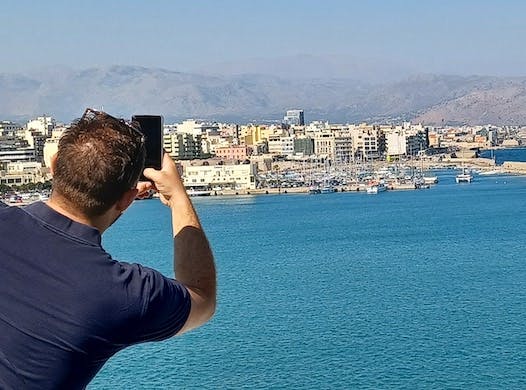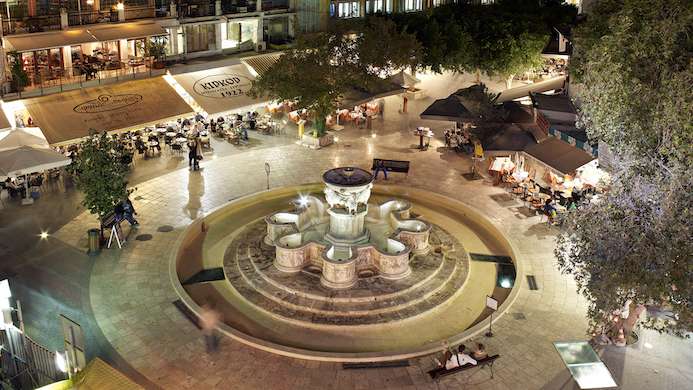Venetians’ Influence on Heraklion Felt Centuries After It Slipped From Their Grasp
Is it a kinder, gentler Cairo? No, but like many places on the edge of the Levant, noisy, congested Irakleio — the Greek word for Crete’s quixotic regional capital — is not the kind of place to wear its heart on its sleeve.

“I hate Irakleio,” an Athenian friend said with a sniff, using the Greek word for Crete’s quixotic regional capital, Heraklion, after I said I would be spending a few days there. A city named after the ancient hero Hercules was enough of a draw for me. Oddly, though, I realized the one essential ingredient that makes Crete what it is – the sea – is strikingly absent from the life of its largest town. Yes, it is best to arrive by boat, and there is a port for that, but for reasons of geography and history it is on the periphery of this very sunny city.
Is it a kinder, gentler Cairo? No, but like many places on the edge of the Levant, noisy, congested Irakleio is not the kind of place to wear its heart on its sleeve. At first it can seem rather hard and inscrutable and, yes, much unloved, save for its renowned archaeological museum. Yet even those famously unsentimental Venetians held it close while the rest of the island slipped from their grasp. Venice’s most obvious traces remain in the form of the thick fortifications that define the old city’s perimeter, guarding the softer urban heart for more than eight centuries now.
I wheel my suitcase up the main thoroughfare of Ethnikis Antistaseos, in the hopes of reaching Leoforos Dimokratias and my hotel, but then I see a great looking bakery with people who look effortlessly tanned and relaxed, and decide it is as good a time as any to take a break and revel in an iced espresso and the absence of tourists.
I walk through some kind of park where people look happier and less rushed than in Athens, and I stop in front of the Monument of National Resistance. The sky glows a soft purple as I continue down the avenue toward the Galaxy Hotel, passing many inviting little restaurants and cafés, and I don’t think of Minoan civilization even once. I can feel guilty about this later, I decide, and take corrective action as necessary.
The spirit I feel here is far more akin to that of Venice (with apologies to native son Nikos Kazantzakis, author of “Zorba”) than to that of anything Greek. It is in the bold strokes – the mighty walls with their poetically named bastions like Martinego and Saint Andreas, and the brooding Koules sea fortress that the Venetians built very well — as well as in the lighter flourishes.
One of those is the landmark Morosini fountain at Liontaria, or Lion’s Square, where everyone seems to end up before deciding which café to park themselves in at night. The lion figures in the fountain aren’t large: One would almost want to tickle their chins were they not made of stone. It helps to adopt a feline attitude as you wander around the center; only then, one step at a time, will you perceive a faded lion of St. Mark chiseled into the upper portion of one of the ramparts, or an old stone arch dating from a more turbulent time that’s set into an otherwise refurbished building.

Morning is the time for a stroll down August 25th Street, past the lovely two-story Loggia that the Venetians built in 1628, and that now houses offices for the city of Irakleio. All that is missing is a canal in front, but never underestimate Venetian sleight of hand; as the avenue slopes gently down to the sea and the pastel façades become more fanciful, I realize that gondolas or not, I am in the middle of Irakleio’s answer to the Grand Canal itself. Cretans are proud, so I keep this thought to myself.
I ditch the beach sandals for a sturdy pair of sneakers and set about inspecting the western fortifications: the bastions of Saint Andreas, Pantokratoros, Bethlehem. I learn that the publication of the “The Last Temptation of Christ” gave cause for the Greek Orthodox Church to excommunicate Kazantzakis, and that as a consequence his tomb is not part of any cemetery but rather atop the Martinego bastion. But oh, if only he were alive to see the sea and city view from that vantage point.
I was told I had to go to a restaurant called Peskesi for an authentic Cretan lunch, so I went. It is fantastic. The tomatoes are a revelation, as are the array of Cretan cheeses and slender medallions of pork grilled with Cretan herbs and honey and theatrically presented.
Other Irakleio peculiarities: Walking the streets of the city, you cannot help but notice how many barbershops there are. I have no idea why, and conduct no survey, but it seems the men of the city are a tad obsessional when it comes to their coiffure. I spot a nice looking barbershop in Milatou Street and enter; it is around noon and not too busy. A young Cretan who looks like he stepped out of a Minoan fresco does the job, and half an hour later I am hitting the streets of Irakleio looking more cosmopolitan than ever, and ready for more Greek coffee with ice cream.
As I navigate the maze of byzantine byways with names like Gorgolaini, Savathianon, Vourdoubadon, and Valestra, I am both captivated by the nomenclature and completely tangled in the web. Here and there I spot what appear to be remnants of Venetian architecture — or maybe my imagination is getting the better of me. In any event, I will let no opportunity for an Instagram-worthy photo opportunity escape without a fight, and they are coming at me fast and furious. In fact, the narrower the streets get, the more photogenic flourishes they seem to offer. The sea seems monotonous next to an unruly labyrinth like this.
Although no Marseille, there is a port here after all, and I must quicken the pace to take in everything before my ship sails on the morrow. I don’t have to worry about not succeeding at a mission undeclared: Irakleio, like some other big island cities I know, simply won’t permit you to see or do it all in one go. Sharp town.

